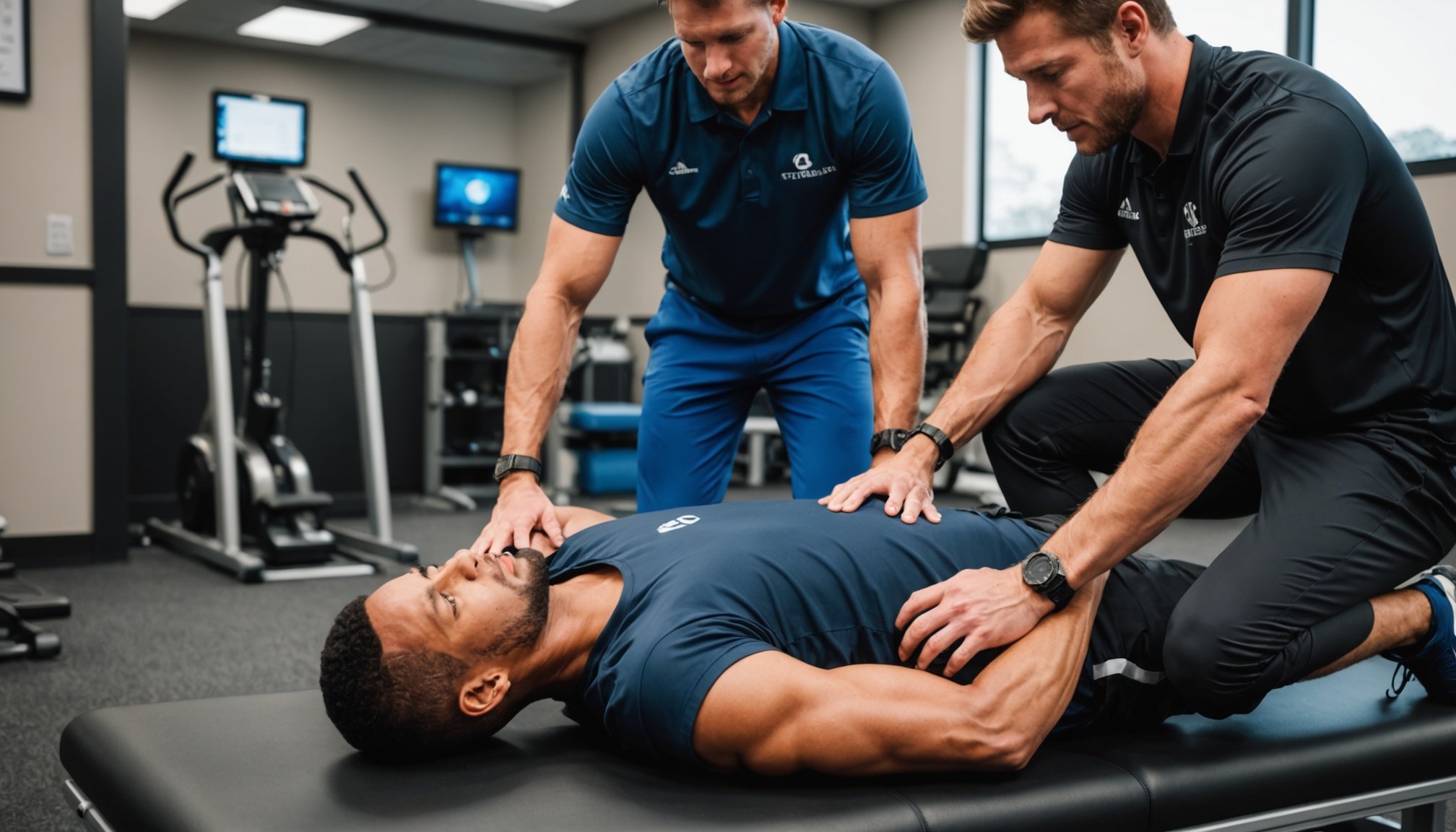Overview of High-Intensity Focused Ultrasound (HIFU) Therapy
HIFU therapy is a cutting-edge treatment that utilises ultrasound technology to facilitate athletic recovery. It employs high-intensity sound waves to target specific tissues, promoting healing without invasive procedures. Developed initially for medical applications beyond sports, HIFU’s role has expanded into rehabilitation, offering a modern solution to conventional sports medicine.
Historically, ultrasound technology has been instrumental in diagnosing and treating sports injuries. With advancements, HIFU has evolved, offering athletes a potent recovery tool. As a therapeutic option, it represents a significant progression from its diagnostic origins, focusing instead on recovery and tissue repair.
Also to see : Building mental toughness: a comprehensive resource for training young athletes in sports academies
In contemporary rehabilitation practices, HIFU is increasingly prevalent, particularly in high-performance sports environments. Its precision in delivering targeted energy makes it effective in managing injuries and accelerating recovery processes. This focused approach allows athletes to benefit from efficient healing while minimising downtime, helping maintain competitive form and reducing long-term injury risks.
The adoption of this therapy underscores a paradigm shift in sports rehabilitation, welcoming a scientific blend of tradition and technology. Athletes and medical professionals now commonly integrate HIFU into injury treatment plans, reflecting its growing importance in modern recovery strategies. As such, understanding this therapy’s mechanics offers valuable insights for both athletes and therapists aiming for optimal rehabilitation outcomes.
Also read : Boosting sports performance: incorporating dynamic visual acuity training into coaching strategies
Benefits of HIFU Therapy for Athletic Recovery
HIFU therapy offers significant benefits for athletic recovery, primarily through its ability to expedite recovery while effectively managing pain and inflammation. This advanced therapy significantly reduces recovery time by enhancing tissue repair, enabling athletes to return to peak performance faster. The focus on precise energy delivery means that HIFU is notably effective in alleviating pain and inflammation, thus promoting a more comfortable healing process.
Moreover, HIFU stimulates increased blood flow and facilitates cellular regeneration, contributing to a holistic recovery. By targeting specific injury sites, HIFU ensures that healing processes are not just quick but also comprehensive. Enhanced blood circulation not only supplies vital nutrients to the injured areas but also assists in the removal of metabolic waste products.
This approach not only addresses immediate recovery needs but also supports long-term athletic wellness by encouraging collagen synthesis and reinforcing cellular structure. The combination of these elements illustrates HIFU’s potential to transform recovery routines, allowing athletes to not just heal but also maintain competitive edge with its comprehensive benefits. Notably, athletes who consistently incorporate HIFU therapy report a noticeable reduction in injury recurrence, underpinning its efficacy as a modern recovery solution in sports medicine.
Mechanisms of Action in HIFU Therapy
Understanding the therapy mechanisms behind High-Intensity Focused Ultrasound (HIFU) is crucial for appreciating its innovative role in sports recovery. This therapy harnesses the power of ultrasound effects to stimulate tissue healing through specific biological processes.
HIFU employs high-intensity ultrasound waves that generate both thermal and non-thermal effects within targeted tissues. The thermal effect involves localized heating, which encourages an immediate physiological response that aids in soft tissue repair. This heating effect not only speeds up recovery but also helps in resurfacing damaged areas efficiently. On the non-thermal side, the mechanical vibrations initiated by ultrasound waves enhance cellular activity, leading to improved tissue regeneration.
One of the notable impacts of HIFU therapy is on collagen synthesis. By stimulating the production of collagen, HIFU strengthens the structural integrity of tissues. This process enhances the resilience of treated areas, making them less susceptible to future injuries. Moreover, the amplification of cellular activity ensures that the healing is not just rapid but also comprehensive. This cohesive approach, combining thermal and mechanical actions, underscores why HIFU is a forefront choice in modern athletic rehabilitation. Understanding these mechanisms allows athletes and practitioners to harness HIFU effectively for optimal recovery outcomes.
Case Studies and Testimonials from Football Players
In the realm of sports, particularly football, athlete testimonials bolster the credibility of HIFU therapy. Many footballers have shared their HIFU success stories, illustrating its transformative impact on their rehabilitation experiences. One prime example is when an athlete suffered a recurring hamstring injury. Traditional methods previously failed to prevent the problem’s resurgence. However, by incorporating HIFU into his recovery plan, he reported remarkable improvements. This included shorter recovery times and decreased pain levels.
Other rehabilitation experiences highlight successful recoveries from ankle sprains and ligament tears. Footballers often undergo rigorous training, predisposing them to such injuries. Yet, with HIFU’s targeted approach, players have resumed training sooner than anticipated, thus minimising downtime. Personal testimonies reveal HIFU’s capacity to enhance performance levels, providing not just recuperation but also increased strength and resilience.
Moreover, numerous football clubs now incorporate HIFU into their standard injury treatment protocols. This shift underscores the measurable outcomes achieved post-HIFU treatment. For instance, improved joint mobility and reduced inflammation are commonly reported benefits. These real-life applications and testimonials underscore HIFU’s growing importance in athletic recovery, unlocking new potential for performance and longevity in sports careers.
Comparison with Traditional Recovery Methods
When evaluating HIFU therapy against traditional recovery methods, a distinct emphasis emerges on efficiency and precision. Unlike manual techniques and conventional physical therapy, HIFU offers a non-invasive solution that targets specific tissues with high-intensity ultrasound waves. This precision minimises recovery time, a critical advantage for athletes seeking rapid results.
Traditional physical therapy encompasses a range of manual approaches, such as massage and joint manipulation, which generally require multiple sessions to achieve noticeable improvements. They excel in hands-on treatments that can be customised for various injury types. However, HIFU surpasses these techniques by directly stimulating tissue repair and enhancing cellular activity without the need for extended treatment periods.
Incorporating both methods can lead to enhanced recovery outcomes. For instance, while traditional therapies offer a personalised touch, integrating HIFU therapy provides targeted energy delivery, effectively alleviating pain and inflammation. It is advantageous to combine these approaches, using HIFU for specific injuries and manual therapy for overall maintenance.
The pros and cons of integrating HIFU should be considered, especially regarding cost and accessibility. However, its ability to complement existing recovery techniques underscores its growing role in contemporary rehabilitation practices, offering an advanced layer to traditional sports medicine.
Research Findings on HIFU and Athletic Recovery
Recent research studies investigating High-Intensity Focused Ultrasound (HIFU) underscore its efficacy in treating sports injuries. These studies reveal compelling results, showcasing how this ultrasound technology enables accelerated healing through precise targeting of injured tissues. Data gleaned from these scientific inquiries highlight HIFU’s capability in reducing inflammation and promoting sustainable tissue repair.
Scientific findings in the realm of sports medicine corroborate HIFU’s advanced approach towards managing athlete recovery. Trials demonstrate that athletes receiving regular HIFU sessions exhibit significantly shorter recovery periods compared to traditional treatment methods. These insights affirm the technology’s role in expediting recuperation while enhancing overall pain management.
Experts in sports medicine advocate for integrating HIFU into athletic recovery for its potential to transform rehabilitation practices. Emphasising its non-invasive nature and efficiency, they regard HIFU as a promising alternative to more conventional therapies. Future research is likely to delve into HIFU’s broader applications, aiming to innovate further and refine techniques for optimal results.
Potential directions include exploring combinations of HIFU with emerging technologies and therapies. This forward-thinking approach could potentially unlock new dimensions in sports medicine, offering novel avenues for athletes striving to maintain peak performance.
Practical Applications of HIFU in Recovery Routines
Integrating HIFU therapy into sports recovery routines requires thoughtful planning and execution. For many athletes, knowing how to effectively incorporate this advanced treatment into their training and recovery can substantially enhance performance and longevity.
Guidelines for embedding HIFU into recovery plans involve assessing specific injury types and determining the appropriate frequency and duration of sessions. Typically, using HIFU every few days for acute injuries can significantly promote healing. Meanwhile, chronic conditions might benefit from more extended treatment periods with regular evaluations.
Athletes and trainers should consider individual needs when choosing HIFU therapy. For optimal results, consider these key factors:
- Injury Severity: Tailor HIFU frequency based on whether the injury is acute or chronic.
- Performance Goals: Align HIFU use with personal training targets and schedules.
- Professional Advice: Consult healthcare providers to customise treatment plans.
This tailored approach ensures that each athlete fully leverages HIFU’s benefits, aligning with their unique recovery needs. Ultimately, integrating HIFU within training regimens can boost recovery efficacy and sustain peak performance levels over time.

